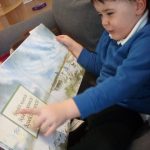Books, books and more books! Children are introduced to songs and rhymes with whole-body movement, finger play and actions, props and pictures are introduced to support songs and rhymes. Nursery rhymes engage children in small manageable chunks of text, giving children experiences of alliteration, rhyme and rhythm in a context which develops their speaking and listening.
Simple stories are introduced, again supported by props. Props match well to the developmental emergence of symbolic understanding where there is a close relationship between the symbol and the real object. Simple stories for young children deal with familiar events; props represent familiar objects and animals. Through involvement in stories and playing with props, children move from beyond the “here and now”, enhancing their imaginative life. Children rely less on props and can sustain involvement in more complex stories through the text and illustrations alone, though props remain important to play with the ideas and storylines.
We vary group sizes, so that we can tailor the experience to the individual needs of each child, and so that children have an opportunity to speak and actively listen (rather than just “sit up nicely”). The pace of group sessions is carefully planned, with a mixture of stories, songs and rhymes. In small groups, children are helped to focus their attention to sounds – musical (instruments, listening to music, making sounds with the body), environmental, and the sounds of letter and words. Children experiment with their voices making a wide range of sounds, at different pitches and volumes.
The skills of segmenting and blending are founded on the earlier experiences of enjoying rhymes and songs, and developing an ability to focus attention to sounds. They are developed through in-context fun with words and sounds: alliteration, stumbling as we say “p-p-p-penguin” and identifying the initial sound in words and how they rhyme e.g. reading The Cat in the Hat and getting children to guess the word from just the initial sound or from the rhyme) and then further breaking words down (segmenting into their individual phonemes). Children are encouraged to play with sounds, experimenting with new rhymes (e.g. “Twinkle twinkle chocolate bar”). Staff model pronunciation of sounds with care.
Through the enjoyment of stories, the children learn about the characters, about the formal arrangement of books (with covers, titles, text and sometimes speech bubbles) and that a story has a structure – a beginning, middle and end. All story books are very carefully selected for rich and engaging language, often with repetition and refrains; for high quality illustrations; and to show a range of ethnic groups, cultures, types of families, women and men in various roles, different places, etc. Children’s knowledge of print in books is built on their awareness of print in the environment – signs, logos, brands etc. In the third year, we help draw children’s attention to letters and words in environmental print. Staff make books with children about memorable experiences, and children are also able to make their own books when they please. ICT resourcing enables the use of photos (taken by children or adults) to be incorporated.
Non-fiction books begin with the simplest board books about familiar objects, people and animals and range to carefully structured and accessible books (e.g. books and leaflets which categorise birds into different species) that help children to structure and reflect upon their experiences of the world around them, and learn new facts. These books are used to support displays, and to add information to enhance and deepen the experiences that the nursery provides. The book corner is a place where children can share a book with another adult, or experience a book on tape/cd. It is a place with a special atmosphere of calm, reflection and thoughtfulness. Our stock of books is uniformly high quality and includes books in different languages and books which represent the diversity of the children who come to Oxhill. Children are able to borrow books and to repeat the experience of their favourite stories in the intimate environment of their homes.
Please checkout the full article below;
Adobe Reader
You may need a product like Adobe Reader (free download) to view our PDF documents on our website.







